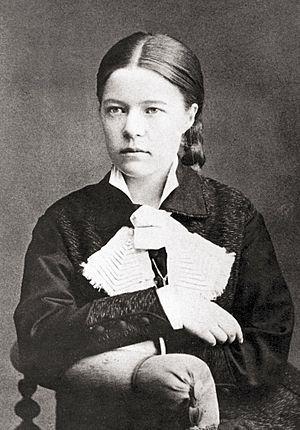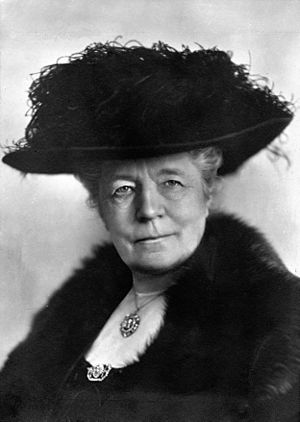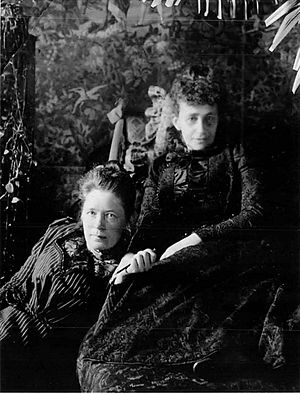Selma Lagerlöf facts for kids
Quick facts for kids
Selma Lagerlöf
|
|
|---|---|
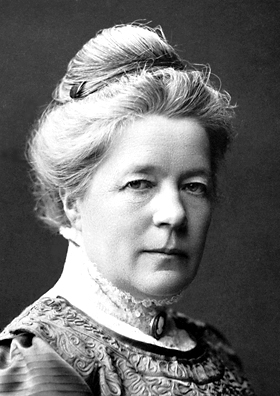
Lagerlöf in 1909
|
|
| Born | Selma Ottilia Lovisa Lagerlöf 20 November 1858 Mårbacka, Sweden |
| Died | 16 March 1940 (aged 81) Mårbacka, Sweden |
| Occupation | Writer |
| Nationality | Swedish |
| Notable awards | Nobel Prize in Literature 1909 |
Selma Ottilia Lovisa Lagerlöf (born November 20, 1858 – died March 16, 1940) was a famous Swedish author. She published her first novel, Gösta Berling's Saga, when she was 33 years old. She made history by becoming the first woman to win the Nobel Prize in Literature in 1909. She was also the first woman to become a member of the Swedish Academy in 1914.
Contents
Selma Lagerlöf's Life Story
Her Early Years and Childhood

Selma Ottilia Lovisa Lagerlöf was born on November 20, 1858, in Mårbacka, Värmland, Sweden. Her father, Erik Gustaf Lagerlöf, was an army officer. Her mother, Louise Lagerlöf, came from a family of wealthy merchants. Selma was the fifth of six children.
When she was born, Selma had a problem with her hip. At three and a half years old, she became sick and couldn't use her legs well, but she later got better.
Selma was a quiet and serious child. She loved to read books. Her grandmother often told her stories, including fairytales and fantasy tales. Selma started writing poetry when she was young, but she didn't publish anything until she was older. She was taught at home because the public school system was not fully set up yet. She learned English and French. After reading a book called Osceola when she was seven, she decided she wanted to be a writer.
In 1868, when Selma was 10, she started reading the Bible. Her father was very sick, and she hoped that reading the Bible would help him get well. Her father lived for another 17 years. Reading the Bible so much helped Selma become familiar with its language.
In 1884, her family had to sell their home, Mårbacka. This was a very sad time for her. Later in life, after she won the Nobel Prize, she used the prize money to buy her childhood home back. She lived there for the rest of her life. In the same year her father died, she also finished her studies to become a teacher.
Becoming a Teacher
Selma Lagerlöf studied in Stockholm from 1882 to 1885 to become a teacher. From 1885 to 1895, she worked as a high school teacher for girls in Landskrona. During this time, she practiced her storytelling skills. She especially focused on the old legends she had heard as a child. She enjoyed teaching and liked her students. She was good at getting the children's attention by telling them stories about different countries or about Jesus and his followers. While teaching, Selma lived with her aunt, Lovisa Lagerlöf.
While studying, Lagerlöf did not like the realistic writing style of some Swedish authors at the time. She started writing her first novel, Gösta Berling's Saga, while teaching. She got her first big chance as a writer when she sent the first parts of her book to a writing contest. She won, and her book was published. At first, critics didn't praise her writing much. But when a famous critic, Georg Brandes, gave her positive reviews, her books became very popular. She also received money from a kind supporter, Fredrika Limnell, which allowed her to focus more on her writing.
Selma Lagerlöf's Writing Career
In 1900, Selma Lagerlöf visited a place called the American Colony in Jerusalem. This trip gave her the idea for her book named Jerusalem. The royal family and the Swedish Academy gave her a lot of money to help her continue writing. Jerusalem was also praised by critics. They even compared her to famous writers like Homer and Shakespeare. She became well-known in Sweden and other countries.
By 1895, she stopped teaching to focus only on her writing. With money from Gösta Berling's Saga and a scholarship, she took two important trips. These trips helped her gather ideas for her next novel. She traveled to Italy with her close friend Sophie Elkan. She also went to Palestine and other parts of the East. In Italy, she heard a story about a fake Christ Child statue. This story inspired her novel Antikrists mirakler (The Miracles of the Antichrist). This book, set in Sicily, explores ideas about Christian beliefs and socialist ideas. However, most of Lagerlöf's stories were set in her home region of Värmland.
In 1902, the National Teachers' Association asked Lagerlöf to write a geography book for children. She wrote Nils Holgerssons underbara resa genom Sverige (The Wonderful Adventures of Nils). This novel is about a boy from southern Sweden who shrinks to the size of a thumb. He travels across the country on the back of a goose. Lagerlöf mixed real facts about Sweden's history and geography with the boy's adventures. The story ends when he returns home and becomes his normal size again. This novel is one of Lagerlöf's most famous books. It has been translated into more than 30 languages.
In 1897, she moved to Falun. There, she met Valborg Olander, who became her literary assistant and friend. Olander was also a teacher and worked for the women's right to vote movement in Sweden. Selma Lagerlöf herself was an active speaker for the National Association for Women's Suffrage. Her involvement was very helpful for the organization because people respected her so much. She gave the opening speech at the International Suffrage Congress in Stockholm in June 1911. She also spoke at the celebration after women in Sweden gained the right to vote in May 1919.
Selma Lagerlöf was a friend of the German-Jewish writer Nelly Sachs. Shortly before Lagerlöf died in 1940, she helped Nelly Sachs and her elderly mother escape from Nazi Germany. She asked the Swedish royal family for help. They were able to get on the last flight from Germany to Sweden. They found a safe home in Stockholm for the rest of their lives.
Personal Connections
In 1894, Selma Lagerlöf met the Swedish writer Sophie Elkan. They became close friends and companions. For many years, Elkan and Lagerlöf would read and give feedback on each other's writing. Lagerlöf wrote that Elkan had a strong influence on her work. She also said they often disagreed about the direction her books should take. Selma's letters to Sophie were published in 1993. The book was called Du lär mig att bli fri (You Teach me to be Free).
From the 1900s, Selma also had a close relationship with Valborg Olander. Valborg helped her as a writing advisor, agent, and secretary. Their letters were published in 2006 as En riktig författarhustru (A Proper Writer's Wife). It seems there was a strong rivalry between Elkan and Olander while they were both alive. Both relationships were very close and emotional. At that time, it was not common to talk openly about same-sex relationships.
Books Made into Movies
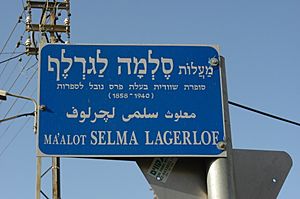
In 1919, Selma Lagerlöf sold the movie rights for all her future books to a Swedish film company. Because of this, many movies were made based on her works over the years. During the time of silent movies in Sweden, directors like Victor Sjöström and Mauritz Stiller used her stories. Sjöström's films, based on Lagerlöf's tales of Swedish village life, showed the details of traditional life and the beautiful Swedish landscape. These movies became some of the most memorable silent films. Her novel Jerusalem was also made into a well-known film in 1996.
Awards and Recognition
On December 10, 1909, Selma Lagerlöf won the Nobel Prize in Literature. She received it for her "high ideals, vivid imagination, and spiritual insight" in her writing. However, there was a big debate within the Swedish Academy before they chose her. During her acceptance speech, she was very humble. She told a wonderful story about visiting her father in heaven. In the story, she asks her father for help with a debt she owes. Her father explains that the debt is from all the people who supported her throughout her career.
In 1904, the Swedish Academy had given her its great gold medal. In 1914, she also became a member of the academy. For both the academy membership and her Nobel Prize, she was the first woman to receive such honors. She also received the Litteris et Artibus award in 1909 and the Illis quorum in 1926. In 1991, she became the first woman to be shown on a Swedish banknote, appearing on the 20-kronor note.
In 1907, she received an honorary degree from Uppsala University. In 1928, she received another honorary doctorate from the University of Greifswald. At the start of World War II, she sent her Nobel Prize medal and her gold medal from the Swedish Academy to the government of Finland. She wanted to help them raise money to fight the Soviet Union. The Finnish government was so touched that they found the money in other ways and returned her medals to her.
Two hotels in Östra Ämtervik are named after her. Her home, Mårbacka, is now a museum that people can visit.
Published Works
Here are some of Selma Lagerlöf's most famous books. Many of them were translated into English by Velma Swanston Howard, who believed Americans would enjoy her stories.
- Gösta Berlings saga (1891) – known in English as Gösta Berling's Saga
- Osynliga länkar (1894) – translated as Invisible Links
- Antikrists mirakler (1897) – translated as The Miracles of Antichrist
- Drottningar i Kungahälla (1899) – translated as The Queens of Kungahälla
- En herrgårdssägen (1899) – translated as The Tale of a Manor
- Jerusalem: två berättelser. 1, I Dalarne (1901) – translated as Jerusalem
- Jerusalem: två berättelser. 2, I det heliga landet (1902) – translated as The Holy City : Jerusalem II
- Herr Arnes penningar (1903) – translated as Herr Arne's Hoard or The Treasure. It was made into the 1919 film Sir Arne's Treasure.
- Kristuslegender (1904) – translated as Christ Legends and Other Stories
- Nils Holgerssons underbara resa genom Sverige (1906–07) – translated as The Wonderful Adventures of Nils
- En saga om en saga och andra sagor (1908) – translated as The Girl from the Marsh Croft
- Liljecronas hem (1911) – translated as Liliecrona's Home
- Körkarlen (1912) – translated as Thy Soul Shall Bear Witness!. This book was made into the famous film The Phantom Carriage.
- Kejsarn av Portugallien (1914) – translated as The Emperor of Portugallia
- Mårbacka (1922) – a memoir about her childhood home, translated as Marbacka: The Story of a Manor
- The Ring trilogy:
- Löwensköldska ringen (1925) – translated as The General's Ring or The Löwensköld Ring
- Charlotte Löwensköld (1925)
- Anna Svärd (1928)
- Dagbok för Selma Ottilia Lovisa Lagerlöf (1932) – translated as The Diary of Selma Lagerlöf
|
See also
 In Spanish: Selma Lagerlöf para niños
In Spanish: Selma Lagerlöf para niños


